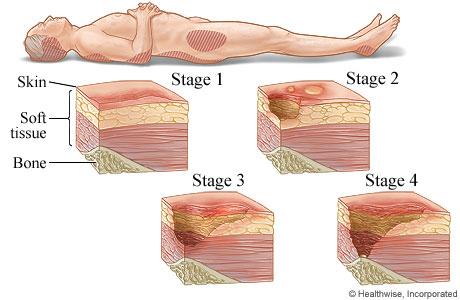A nurse is caring for a client with a wound. Which of the following pairings reflect the correct wound infection stage with description?
Colonization - replicating microorganisms: not yet Infected
Systemic infection - Wound is darker than the surrounding skin with noted drainage present
Contaminated - infection beyond the wound
Local infection - sepsis
The Correct Answer is A
A. Colonization - replicating microorganisms: not yet Infected
This pairing is correct. Colonization refers to the presence and replication of microorganisms on the wound surface. At this stage, the wound is not yet infected, as there may be microorganisms present, but they have not caused an inflammatory response or tissue damage.
B. Systemic infection - Wound is darker than the surrounding skin with noted drainage present
This description does not match the stage of systemic infection. Systemic infection refers to an infection that has spread beyond the initial wound site, affecting the entire body systemically. The symptoms of systemic infection may include fever, increased heart rate, malaise, and altered mental status. The description provided seems more indicative of a local infection with drainage.
C. Contaminated - infection beyond the wound
This pairing is incorrect. Contaminated wounds refer to wounds with a high risk of infection due to the presence of foreign material or significant contamination. However, contamination does not necessarily mean that an infection has already developed beyond the wound. It signifies a risk of infection but does not define the infection stage itself.
D. Local infection - sepsis
This pairing is incorrect. A local infection is confined to the wound site and may present with symptoms such as erythema, warmth, swelling, pain, and purulent drainage. Sepsis, on the other hand, is a severe systemic response to infection, characterized by widespread inflammation and organ dysfunction. Sepsis is not synonymous with a local infection; it represents a more advanced and life-threatening stage of infection.
Nursing Test Bank
Naxlex Comprehensive Predictor Exams
Related Questions
Correct Answer is C
Explanation
A. Cluster of oral herpes sores: Oral herpes sores typically heal within a few weeks and do not generally become chronic wounds unless there are complications or underlying immune system issues. They are more acute in nature and tend to resolve without becoming chronic.
B. Abdominal surgical incision: Surgical incisions are designed to heal within a specific timeframe, usually a few weeks to a couple of months, depending on the type of surgery and individual healing factors. While surgical wounds can sometimes have delayed healing or complications, they are not typically categorized as chronic wounds unless they fail to heal or become recurrent over an extended period.
C. Diabetic foot ulcer: Diabetic foot ulcers are highly prone to becoming chronic wounds due to the underlying pathology associated with diabetes, such as neuropathy (nerve damage), peripheral vascular disease (poor circulation), and impaired immune function. These factors can impair the normal healing process, leading to delayed healing, infection, and the potential for the wound to become chronic if not managed appropriately.
D. Posterior scalp wound: Scalp wounds can heal relatively quickly, especially with proper wound care and management. However, certain factors such as the size of the wound, depth, presence of infection, and underlying conditions can influence the likelihood of a scalp wound becoming chronic. In general, scalp wounds are less likely to become chronic compared to wounds in areas with higher risk factors, such as diabetic foot ulcers.
Correct Answer is D
Explanation
A. Stage III pressure injury
Stage III pressure injuries involve full-thickness skin loss, extending into the subcutaneous tissue but not through the fascia. These wounds typically present as deep craters and may involve undermining or tunneling. Non-blanchable erythema alone without visible skin loss is not characteristic of a Stage III pressure injury.
B. Stage IV pressure injury
Stage IV pressure injuries are the most severe and involve full-thickness tissue loss with exposed bone, tendon, or muscle. These wounds often have extensive tissue damage and can be difficult to manage. Again, non-blanchable erythema without visible skin loss is not indicative of a Stage IV pressure injury.
C. Stage II pressure injury
Stage II pressure injuries involve partial-thickness skin loss with damage to the epidermis and possibly the dermis. These wounds often present as shallow open ulcers or blisters and may have characteristics such as intact or ruptured blisters. While Stage II injuries can present with erythema, non-blanchable erythema specifically indicates a Stage I injury.
D. Stage I pressure injury
Stage I pressure injuries are the earliest stage and involve non-blanchable erythema of intact skin. The skin may be warmer or cooler than surrounding tissue and may have changes in sensation. There is no visible skin loss at this stage, but the area is at risk for further injury if pressure is not relieved. Therefore, non-blanchable erythema on the heels most likely indicates a Stage I pressure injury.

Whether you are a student looking to ace your exams or a practicing nurse seeking to enhance your expertise , our nursing education contents will empower you with the confidence and competence to make a difference in the lives of patients and become a respected leader in the healthcare field.
Visit Naxlex, invest in your future and unlock endless possibilities with our unparalleled nursing education contents today
Report Wrong Answer on the Current Question
Do you disagree with the answer? If yes, what is your expected answer? Explain.
Kindly be descriptive with the issue you are facing.
